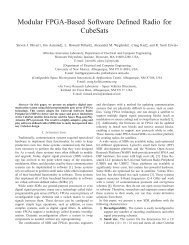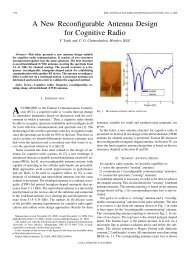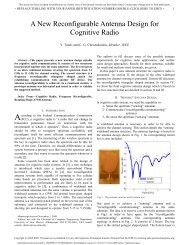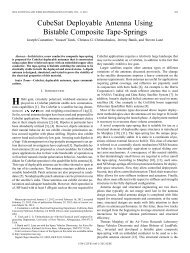Reducing Redundancies in Reconfigurable Antenna ... - IEEE Xplore
Reducing Redundancies in Reconfigurable Antenna ... - IEEE Xplore
Reducing Redundancies in Reconfigurable Antenna ... - IEEE Xplore
You also want an ePaper? Increase the reach of your titles
YUMPU automatically turns print PDFs into web optimized ePapers that Google loves.
800 <strong>IEEE</strong> TRANSACTIONS ON ANTENNAS AND PROPAGATION, VOL. 59, NO. 3, MARCH 2011Fig. 15. Comparison of simulated and measured <strong>in</strong>put reflection for the (10)optimized case.tween the measured and simulated S11 for the (10) optimizedcase is shown <strong>in</strong> Fig. 15.[4] E. Klav<strong>in</strong>s, “Programmable self assembly,” <strong>IEEE</strong> Control Syst. Mag.,vol. 27, no. 4, pp. 43–56, Aug. 2007.[5] J. Costant<strong>in</strong>e, C. G. Christodoulou, and S. E. Barb<strong>in</strong>, “Mapp<strong>in</strong>g reconfigurableantennas us<strong>in</strong>g graphs,” <strong>in</strong> Proc. NASA/ESA Conf. on AdaptiveHardware and Systems, Jun. 2008, pp. 133–140.[6] A. Patnaik, D. E. Anagnostou, C. G. Christodoulou, and J. C. Lyke,“Neurocomputational analysis of a multiband reconfigurable planar antenna,”<strong>IEEE</strong> Trans. <strong>Antenna</strong>s Propag., vol. 53, no. 11, pp. 3453–3458,Nov. 2005.[7] L. M. Feldner, C. D. Nordquist, and C. G. Christodoulou, “RFMEMSreconfigurable triangular patch antenna,” <strong>in</strong> Proc. <strong>IEEE</strong> AP/URSI Int.Symp., Jul. 2005, vol. 2A, pp. 388–391.[8] J. Costant<strong>in</strong>e, C. G. Christodoulou, and S. E. Barb<strong>in</strong>, “A new reconfigurablemulti band patch antenna,” <strong>in</strong> Proc. <strong>IEEE</strong> IMOC Conf., Salvador,Brazil, Oct. 2007, pp. 75–78.[9] A. Grau, L. M<strong>in</strong>g-Jer, J. Romeu, H. Jafarkhani, L. Jofre, and F. DeFlaviis, “A multifunctional MEMS-reconfigurable pixel antenna fornarrowband MIMO communications,” <strong>in</strong> Proc. <strong>IEEE</strong> <strong>Antenna</strong>s andPropagation Society Int. Symp., Jun. 2007, pp. 489–492.[10] R. G. Vaughan, “Two-port higher mode circular microstrip antennas,”<strong>IEEE</strong> Trans. <strong>Antenna</strong>s Propag., vol. 36, no. 3, pp. 309–321, Mar. 1988.[11] J. Costant<strong>in</strong>e, C. G. Christodoulou, C. T. Abdallah, and S. E. Barb<strong>in</strong>,“Optimization and complexity reduction of switch-reconfigured antennas,”<strong>IEEE</strong> <strong>Antenna</strong>s Wireless Propag. Lett., vol. 8, pp. 1072–1075,2009.[12] A. Ramadan, K. Y. Kabalan, A. El-Hajj, S. Khoury, and M. Al-Husse<strong>in</strong>i,“A reconfigurable U-Koch microstrip antenna for wireless applications,”Progr. Electromagn. Res., vol. PIER 93, pp. 355–367, 2009.VI. CONCLUSIONIn this paper, graphs are <strong>in</strong>troduced as a model<strong>in</strong>g tool for reconfigurableantennas. Guidel<strong>in</strong>es for graph model<strong>in</strong>g differenttypes (multi-part and s<strong>in</strong>gle part) of switch reconfigurable antennasare presented.We also present a new methodology for remov<strong>in</strong>g redundanciesfrom antenna structures. This approach is based on compar<strong>in</strong>gthe number of unique paths <strong>in</strong> a given graph with thenumber of the required antenna configurations. Equations are<strong>in</strong>troduced for different types of switch reconfigurable antennas.In some cases redundant elements are simply removed from theantenna structures and <strong>in</strong> different cases a complete redesign<strong>in</strong>gof the antenna is required. This optimization approach is an efficienttool for reduc<strong>in</strong>g costs and losses <strong>in</strong> reconfigurable antennastructures. Examples are given on multi and s<strong>in</strong>gle-part switchreconfigured antennas, validat<strong>in</strong>g the discussed approach withsimulations and measurement. Furthermore this easy approachdoes not replace the simulation <strong>in</strong> a design process however itreduces the number of iterations needed.In addition, this paper proposes a complexity reduction approachwhile ma<strong>in</strong>ta<strong>in</strong><strong>in</strong>g the desired multi-functional propertiesof a reconfigurable antenna, and facilitates the control ofsuch antennas by us<strong>in</strong>g correspond<strong>in</strong>g graph algorithms.REFERENCES[1] J. T. Bernhard, <strong>Reconfigurable</strong> <strong>Antenna</strong>s. San Rafael, CA: Morganand Claypool, 2007.[2] C. A. Balanis, Modern <strong>Antenna</strong> Handbook. Hoboken, NJ: Wiley,2008.[3] T. H. Cormen, C. E. Leiserson, R. L. Rivest, and C. Ste<strong>in</strong>, Introductionto Algorithms, 2nd ed. Cambridge, MA: MIT press, 2001.Joseph Costant<strong>in</strong>e (M’10) received the B.E. degree<strong>in</strong> electrical, electronics, computer, and communicationseng<strong>in</strong>eer<strong>in</strong>g from the Lebanese University, <strong>in</strong>2004, the M.E. degree <strong>in</strong> computer and communicationseng<strong>in</strong>eer<strong>in</strong>g from the American University ofBeirut, Beirut, Lebanon, <strong>in</strong> 2006, and the Ph.D. degree<strong>in</strong> electrical and computer eng<strong>in</strong>eer<strong>in</strong>g from theUniversity of New Mexico, Albuquerque, <strong>in</strong> 2009.In July 2010, he completed his Postdoctoral Fellowship<strong>in</strong> the Computer Eng<strong>in</strong>eer<strong>in</strong>g Department,University of New Mexico. Currently he is an AssistantProfessor at the Electrical Eng<strong>in</strong>eer<strong>in</strong>g Department, California State University,Fullerton. He has also published many research papers and is a co-authorof an upcom<strong>in</strong>g book on reconfigurable antennas. His research <strong>in</strong>terests are<strong>in</strong> the areas of reconfigurable systems and antennas, antennas <strong>in</strong> wireless communications,electromagnetic fields, RF Electronic Design and communicationsystems.Dr. Costant<strong>in</strong>e was awarded a 6-month research scholarship at Munich Universityof Technology (TUM) <strong>in</strong> 2006 as part of the TEMPUS program. Hereceived many awards dur<strong>in</strong>g his studies and career.S<strong>in</strong>an al-Saffar (M’10) received the M.S. degree<strong>in</strong> computer science from Arizona State University,<strong>in</strong> 1998, where his research focused on paralleland high performance comput<strong>in</strong>g, and the Ph.D.degree <strong>in</strong> computer eng<strong>in</strong>eer<strong>in</strong>g from the Universityof New Mexico, Albuquerque, <strong>in</strong> 2009. His Ph.D.work focused on apply<strong>in</strong>g semantic graphs andcomputation to subjective <strong>in</strong>formation valuation.Previously, he spent a few years <strong>in</strong> Silicon Valleywhere his <strong>in</strong>dustry experience matured around paralleland high performance database systems, beforereturn<strong>in</strong>g to academia. Currently, he is a Senior Computer Scientist at the PacificNorthwest National Laboratory, Seattle, WA. His present research at PNNLcomb<strong>in</strong>es data-<strong>in</strong>tensive comput<strong>in</strong>g and semantic graph m<strong>in</strong><strong>in</strong>g for automatedknowledge discovery.Dr. al-Saffar is an active member <strong>in</strong> the ACM and AAAS.










